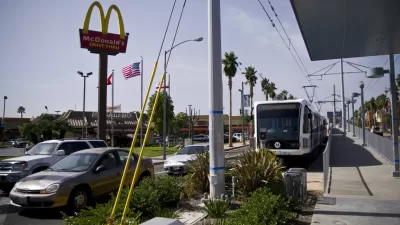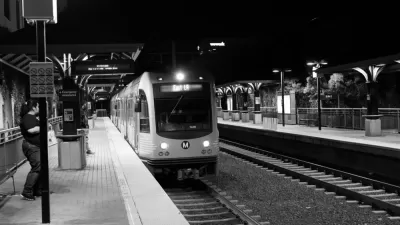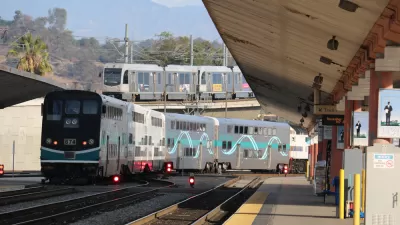Bus riders, comprising about three-quarters of Los Angeles Metro ridership, declined 21 percent since 2013, But it wasn't just bus routes—two light rail lines also lost riders.

"Despite a growing population and an improving economy, the number of trips taken on Los Angeles County's bus and rail network last year fell to the lowest level in more than a decade," reports Laura J. Nelson, who covers transportation and mobility issues across Southern California for the Los Angeles Times, on Jan. 25.
The Los Angeles County Metropolitan Transportation Authority, or Metro, is the third largest public transit agency in the U.S. ranked by ridership, according to APTA [pdf].
Rail ridership increased 3.6 percent over five years, bolstered by significant ridership gains on the Expo Line on the new extension to Santa Monica and Gold Line extension to Azusa, adds Nelson, but the Blue and Green light rail lines saw ridership drop 21 percent and 26 percent, respectively.
So, why the drop, though It should be noted that bus ridership is falling nationwide, with Seattle a major exception.
Experts and officials have no firm answers, but have attributed the decline to a combination of factors, including changes to immigration policy, competition from Uber and Lyft and more people buying cars — as well as perceived problems with existing transit service and security. [Note the anecdote by Councilwoman Nury Martinez in the article.]
Nearly two-thirds of former Metro riders told the agency in a 2016 survey that they stopped riding because transit service was inefficient, inconvenient or difficult to reach. An additional 29% said they stopped riding because they felt unsafe or uncomfortable on buses and trains. The vast majority of those people now drive alone.
One study prepared by UCLA for the Southern California Assn. of Governments suggests that the region simply has more cars available per resident than in the past, making driving easier and making traffic worse.
The change in immigration policy refers to a 2015 state law that allows undocumented immigrants to apply for driver's licenses.
Nelson delves into many strategies, such as bus-only lanes and all-door boarding that would increase bus efficiency, but she also notes their challenges.
It will be interesting to see if the $120 billion expected investment over the next 40 years from Measure M, passed by county voters in 2016, can reverse the trend. That Metro is already using the new sales tax dollars to invest in local bus service, particularly in non-Metro local lines, is a good sign.
"It wouldn't be difficult to turn these [ridership] figures around, as Metro's history shows: The transportation authority should stop focusing primarily on building new rail and use a fair share of its voter-supplied wealth to lower fares and improve the bus system," opined James E. Moore Il and Thomas A. Rubin in an op-ed for the Los Angeles Times on Nov. 10, 2017.
For an alternative look at Metro ridership, particularly rail ridership, see Ethan Elkind's blog, "L.A. Times Misleads On Metro Rail Ridership History," dated January 27, 2016.
Hat tip to Julie Bloom via New York Times - California Today.
FULL STORY: Ridership on Metro fell to the lowest level in more than a decade last year

Alabama: Trump Terminates Settlements for Black Communities Harmed By Raw Sewage
Trump deemed the landmark civil rights agreement “illegal DEI and environmental justice policy.”

Study: Maui’s Plan to Convert Vacation Rentals to Long-Term Housing Could Cause Nearly $1 Billion Economic Loss
The plan would reduce visitor accommodation by 25% resulting in 1,900 jobs lost.

Planetizen Federal Action Tracker
A weekly monitor of how Trump’s orders and actions are impacting planners and planning in America.

Waymo Gets Permission to Map SF’s Market Street
If allowed to operate on the traffic-restricted street, Waymo’s autonomous taxis would have a leg up over ride-hailing competitors — and counter the city’s efforts to grow bike and pedestrian on the thoroughfare.

Parklet Symposium Highlights the Success of Shared Spaces
Parklets got a boost during the Covid-19 pandemic, when the concept was translated to outdoor dining programs that offered restaurants a lifeline during the shutdown.

Federal Homelessness Agency Places Entire Staff on Leave
The U.S. Interagency Council on Homelessness is the only federal agency dedicated to preventing and ending homelessness.
Urban Design for Planners 1: Software Tools
This six-course series explores essential urban design concepts using open source software and equips planners with the tools they need to participate fully in the urban design process.
Planning for Universal Design
Learn the tools for implementing Universal Design in planning regulations.
Caltrans
Smith Gee Studio
Institute for Housing and Urban Development Studies (IHS)
City of Grandview
Harvard GSD Executive Education
Toledo-Lucas County Plan Commissions
Salt Lake City
NYU Wagner Graduate School of Public Service





























